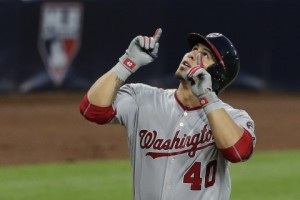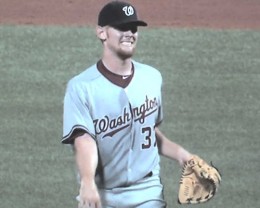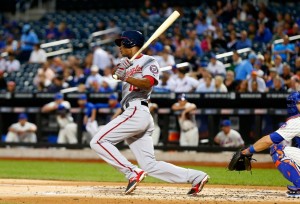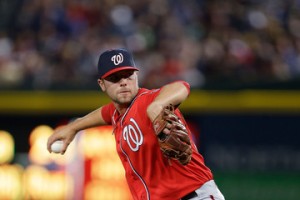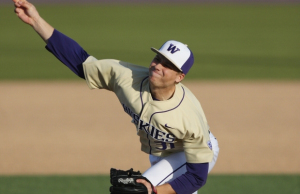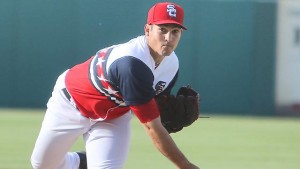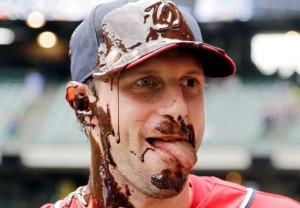Another year, another playoff failure. Beat it to death already. Time to move on.
Lets talk about the post-season “To Do” list is for the Nats. We’ll have eventual posts to talk about other stuff, like Tender decisions, 40-man decisions ahead of the Rule5 draft, etc.
In this post, we’ll squint at the overall roster, look at blatant holes that will need filling, and discuss how they might get filled. Call it the cliche’s “General Manager for a day” post for the Nats this coming off-season.
Pending Free Agents we are waving good-bye to and the holes they thus leave (as per the invaluable Cots site at BaseballProspectus):
- Mark Melancon: though i’d love to re-sign him … see later in the post.
- Wilson Ramos: his injury is a shame for both player and team; he likely lost $50M in guaranteed FA money and the team lost a clear QO-compensation pick. He may not even be able to catch again, which dumps him to the AL, where his market is significantly cut thanks to the lessening of demand for bat-only DH types. Ramos is in serious career jeopardy right now; would he decamp back to the Nats on some sort of minimally guaranteed deal with performance incentives?
- Stephen Drew: also one I hope re-signs; see later in the post.
- Chris Heisey: one who I think is replaceable; look for another cattle call for RH bat options this coming spring training.
- Matt Belisle: despite not making the NLDS roster, he was great for Washington this year and is worth another contract.
- Mark Rzepczynski: He’s been very effective for us, and overall had a good 2016. His 2015 was awful, but he was good before that. Such is the life of specialist relievers.
- Sean Burnett and Mat Latos: both given Sept 2016 tryouts; neither seem likely to be retained.
- Jonathan Papelbon: worth mentioning if only for the payroll flexibility.
Total payroll “savings” from these FAs: roughly $22M. Papelbon’s $11M, Ramos’ $5.3M and the rest total about $6M.
Guys who I think are clear Non-Tenders (probably a topic worth its own post).
- Yusmeiro Petit: $3M option with $500k buyout for 2017; pitched poorly in 2016, didn’t make the post-season roster and should be replaceable on the roster by any number of our AAA starters.
- Ben Revere: $6.25M salary this year, due an arbitration raise for 2017; struggled badly in 2016, lost his job to a guy who had about 2 week of CF experience and didn’t make the post-season roster.
- Aaron Barrett: as heartless as it would be; he’s arb-eligible, still hurt, not likely to be ready by opening day and is completely replaceable as a RH middle reliever).
Total savings from these non-tenders: roughly $10M
Guys who I think its Time to Trade and the holes they thus leave. This also may be worthy of its own whole post.
- Gio Gonzalez: I think the Nats can take advantage of a historically weak FA market for starters and Gio’s very friendly contract (two $12M options for 2017 and 2018) and move him. Yes he struggled this year, but if you look at what middle rotation innings eaters like him are getting these days, $12M is a bargain and he should fetch something we value. Moving him lets some of the guys who are clearly biting on the heels of a deserved rotation spot earn it for 2017 and thus the Nats “save” $11.5M in salary for the 2017 roster.
- Danny Espinosa: As much as I have argued against this, his 2017 playoff performance has solidified in my mind the need to move him. He has his pros (a plus defender range wise, perhaps the best SS arm in the game, and serious power for a SS) and his cons (he hit just .209 this year, he strikes out at about a 30% clip, and his switch hitting capabilities are really in question). Nonetheless, there has to be some demand for a 25-home run capable plus defender SS in a lineup that can afford one crummy batting average at the bottom of the order. Perhaps an AL team that doesn’t have to also bat a sub .200 BA pitcher.
Total savings from these guys getting moved (not counting payroll received in return of course): $15-$16M.
So, adding up all three lines, assuming a steady payroll ceiling similar to this year’s and not counting arbitration raises (or Strasburg‘s new contract), you’d have roughly $47M with which to work. Not bad. Strasburg’s new contract will take $5M away from that flexibility (he made $10M last year, will make $15M next) and arbitration raises for Harper, Rendon and Roark will cost some cash, but that’s a post for another day. Lets call it $30M in available FA dollars when all is said and done.
So, assuming you’re even reading this far and havn’t already started commenting and arguing about that list of players, here’s the presumed holes that losing these 10 players leaves (in order of mention above):
- Closer
- Starting Catcher
- Backup Utility Infielder
- Backup RH bench bat/corner outfielder
- 6th/7th inning RH reliever
- Loogy
- Long Man/Spot starter/7th guy out of the pen
- Backup Outfielder (CF capable)
- Another 6th/7th inning RH reliever
- #5 Starter
- Starting Shortstop
- (and not really counting the “loss” of Burnett and Latos for this discussion)
If we just filled these holes internally, what would it look like?
- Closer: Make Shawn Kelley the closer and move up Treinen and Glover to be 8th inning guys. This leaves a hole later on in the pen for the middle RH relievers (see below)
- Starting Catcher: promote Lobaton to starter and install Severino as the backup. Or switch them; honestly I like Severino’s at-bats; he looks confident. I don’t think Kieboom is ready for the show, so it makes sense to tender Lobaton for one more year.
- Backup Utility Infielder: Difo becomes the first go-to guy to backup Turner/Murphy, but we’ll still need another utility guy.
- Backup RH bench bat/corner outfielder: not much internally to go to; both the 2016 AAA and AA rosters are basically bereft of decent hitting prospects who might be candidates. We’ll be trolling the FA market here for sure. See the next section.
- Two 6th/7th inning RH relievers: We have Gott and Martin on the 40-man; they could step up to replace these two guys like for like. Right now we have five RH relievers under contract for 2017 (Kelley, Treinen, Glover, Gott and Martin) to go along with two lefties (Solis and Perez); that’s not too bad of a bullpen to start out with, but could be improved. And this lineup doesn’t “really” have a long man, so you’d have to think one of Gott or Martin is in AAA to make room for a long-man (likely Martin at this point).
- Loogy: its arguable whether we need another lefty with both Solis and Perez under contract, but they went most of the year this year with three. Matt Grace is still on the 40-man and would be an internal option.
- Long Man/Spot starter/7th guy out of the pen: loser of #5 starter competition (see below)
- Backup Outfielder (CF capable): Michael Taylor, in what likely is his ceiling from here forward.
- #5 Starter: have Sprint Training 2017 tryouts for the #5 starter between Lopez, Giolito, Cole and even Voth (who I’m assuming by that time will be on the 40-man, protected ahead of this coming off-season’s Rule-5 draft). The winner is #5 starter, and one of the losers could be the long-man (well, if the loser is someone like Cole or Voth, who aren’t nearly as “big” of a prospect as Giolito). There’s also the distinct possibility that Lopez’s arm is turned into a closer at some point if he can’t turn over lineups. Check out Lopez’s 2016 splits, specifically SP versus RP and specifically the “Times Facing an Opponent” during the game; as a starter he struggles with the first time through the order, but not as a reliever.
- Starting Shortstop: move Trea Turner to his natural position, leaving a hole in Center.
So, with my “all internal” fill-ins, your 25 man roster for 2017 looks something like this:
- Starters: Scherzer, Strasburg, Roark, Ross, Lopez
- Relievers: Kelley, Treinen, Glover, Gott, Solis*, Perez*, Cole
- Catchers: Lobaton, Severino
- INF Starters: Rendon, Turner, Murphy, Zimmerman
- INF backups: Difo, Robinson
- OF Starters: Werth, Harper
- OF Backups: Taylor, Goodwin
And we’re missing one-two spots that don’t really have natural in-house replacements: another backup infielder and a starting Center fielder.
So, looking at that 25-man roster, where do we see areas of need? This feeds directly into the Off-season Priorities in the next section.
Quick diversion: Notice I didn’t say what position Bryce Harper is playing. Honestly, if Turner is vacating CF and we’re waving good-bye to Espinosa, then I think you have to put Harper in center. Here’s my main arguments for putting him in center (most of which are “anti-arguments” for those who for some reason think he cannot play center):
- He’s young. He just turned 24 for crying out loud; there’s no reason he doesn’t have the youth or athleticism to handle center. Mantle did it while hitting for power. So did Mays. So did Griffey Jr and Aaron for the early part of his career. Trout plays center.
- He’s got the arm (he has the 2nd best statistically rated arm in the majors in 2016), he’s got the speed (21 Stolen bases this year). And now he has years of OF experience on which to depend.
- He’s played there before and played well. Here’s his career fielding stats from fangraphs.com: He had more than 700 innings in CF in 2012 and played it to a fantastic UZR/150 figure of 19.1 and 13 DRS. He was also great there in more limited sample sizes in 2013 and 2015. I leave out 2014 since that was his injury season and its clearly skewed as compared to his other seasons.
- By putting Harper in Center, you vastly open open up the roster possibilities on the FA market. Look at the pending FA last at mlbtraderumors.com and compare/contrast the available options at CF versus LF/RF.
Top FA/Trade Priorities in 2016-2017 Off-season
Fantasy: I view these as not really possible but are listed as “fantasy” wish lists. Both fixate on moving unmovable contracts, so they’ll probably remain fantasies.
- Upgrade 1B: dump Zimmerman and upgrade offensively at that position.
- Upgrade LF: dump Werth and the last year of his deal and find a LF-capable bopper.
- Acquire a leading CF: back up the farm system and dump it out for a leading center fielder. Charlie Blackmon or Andrew McCutchen are names often mentioned thanks to the precarious position their teams face. Mike Trout is the funny name you also hear since he’s so good he’s virtually untrade-able. Unlike Tom Boswell, and as discussed in comments here before, re-signing Ian Desmond to man CF poorly would not be my first choice either. I’d rather go with my “Bryce to Center” plan as laid out above.
Reality
- Corner Outfielder. See above Harper->CF logic. If you want to splurge (and hurt your #1 divisional rival) sign Yoenis Cespedes. Or you could make a big splash and sign Jose Bautista to a 3-yr deal that ends the same time Harper hits FA. Werth remains serviceable in left, where he is mitigated defensively while Bautista still has value in RF. This is where I could see a big chunk of the $30M of FA dollars going. Lord knows we could use another clutch hitter in the middle of the order.
- Closer: Above I said i’d love to re-sign Melancon, but more and more it seems like he’s going to be the 4th prize in a 4-closer musical chairs race. And he’s gonna get paid. And I’m not sure that the Nats are going to pay him. Per the same previously mentioned FA list there’s 5 “active” closers hitting FA: Melancon, Wade Davis, Aroldis Chapman, Kenley Jansen and Sergio Romo There’s a whole slew of guys who are FA who are former closers though, names like Andrew Bailey, Joaquin Benoit, Santiago Casilla, Neftali Feliz, Jason Grilli, Greg Holland, J.J. Hoover, Jonathan Papelbon (haha, just making sure you’re still reading), Joe Smith, Fernando Salas, and Brad Ziegler. There’s probably even more frankly; these were just the ones who stood out as I read the list. Now, i’m not saying most of these guys are legitimate options, but some of these guys were perfectly good as closers and got “layered” by better closers. Take Ziegler for example: he was just fine for Arizona for a while, then got moved to Boston where he got demoted to 8th inning duties. I’d take him as a late-innings bullpen option.
- Bullpen arm: middle reliever: Now, all that being said about Closers, I think maybe what the team does is install one of their existing options as “the closer” and then maybe hire one of these former closers to be an 8th inning/emergency closer kind of guy. That’s essentially what they got last year with Shawn Kelley and that’s worked out ok. I’d go after some of the ex-closer guys listed above, try to get them on an affordable deal (like halfway to closer money maybe) and that’d help off-set the losses of Melancon and Belisle.
- Veteran utility infielder: as noted above, there’s not much in the farm system here. If you keep Espinosa and put him in this role, then this is moot .. but we’ve read over and again about his disposition when he’s not playing. This is kind of why I think we need to move him. He’s more valuable in trade than he is in this bench role. I hope the team re-ups with Stephen Drew honestly; he was solid, can cover all infield positions as needed, and can probably be had for a similar deal as last year. I’d be happy with Difo and Drew and wouldn’t be opposed to perhaps another veteran utility guy to pair with Drew and compete with Difo if we don’t think Difo is up to the task.
Less Likely:
- Backup LF/IB bench bats: While I like Robinson and I think Heisey did a good job this year, one struggled and the other is a FA with no guarantee of returning. I absolutely expect to see another spring training cattle call of veteran bats of the LF/1B type to compete for roster spots. I’m appreciative of Goodwin‘s completely unexpected line at the plate upon his call up; do we think he’s a better lefty bat option off the bench than Robinson? I’m not sure. I also sense (based on anecdotal evidence read over the years) that Robinson is a clubhouse and teammate favorite, which might make it tougher to cut him when the time comes. Especially with a player’s manager type like Dusty Baker. I know this is where MartyC will cry about Matt Skole (likely to depart in MLFA this coming off-season) and I understand; its all about potential versus production and Skole never produced enough during these annual spring training “tryouts” to win his spot.
- Catcher: Here’s where the most arguing may occur. I’m of the belief, after watching Severino down the stretch, that he could slide right into the starting spot right now. I thought he looked good at the plate, took confident at-bats, never looked over matched, and (here’s the kicker) *puts the ball in play!* This lineup has too many strikeouts; Severino struck out just 3 times in his 34 PAs down the stretch. That correlates to about 50 punch-outs over a 600-plate appearance season; that’s awesome. He was known for years for his defense, not his bat, so if he can provide even competent ABs he could be a starter. So i’m up for saving money on the FA market (where the catcher ranks are thin and the prices will get bid up badly as a result). Now, I could absolutely see us re-signing Wilson Ramos to an incentive-laden deal to keep him in house and hopefully get a good second half out of him. Why not? If he signs for $5-6M (basically his salary this year) and then has games played incentives that could take him up to $7 or $8M why wouldn’t he do that here instead of elsewhere? We go into the season with Severino and Lobaton with Kieboom in AAA and when Ramos shows up we (finally?) cut bait on Lobaton and have the two remaining guys platoon. I’d be onboard with that plan.
- Loogy: Why spend money here? Solis and Perez ably fill the need. Do we need a third lefty in the pen at the expense of one of the aforementioned righties? I liked Rzepczynski this year; would he re-sign for reasonable dollars? Would you want him back? There’s several interesting names on the FA list; maybe one of them can be had for cheap.
What can we get in Trade versus buying on the FA market? Payroll implications?
- I suspect that Gonzalez can fetch some seriously valuable resources. He’s an innings eating 4th starter who probably thrives in a pitcher’s park and is significantly less expensive at $12M/year than what something comparable costs on the FA market this year. So can he fetch maybe one MLB-ready player that fits a need above plus maybe one decent prospect? Is that too much?
- Espinosa probably fetches less, unless you can get a GM to fall in love with his power/defense combo and somehow miss his BA and his K rate. By way of comparison, Yunel Escobar (a lesser defender with less power but more contact) fetched us two upper-level pitching prospects in Trevor Gott and Michael Brady (by upper-level I mean AA/AAA level, not top 100 prospects). I’d guess that Espinosa could fetch a bit more since he plays a premium position. So that could end up being more of the needs above plus maybe an additional prospect.
But who knows what we can and cannot get. In Mike Rizzo we trust when it comes to trades; no matter how much we bitch about prospects heading out the door, you’re really hard pressed to find a trade where Rizzo got the short end of the bargain or “lost” the deal. So lets see what he can do.
Payroll implications. I think we could get a $20M/yr corner OF slugger, a former closer at like $6M/year, resign Ramos at $5M, find a utility infielder in the Drew $3M/year range, and then sign a couple of guys to $1.25M conditional deals like what Belisle and Heisey got and fit right into the $145M payroll budget, even after arbitration raises.
Well; that’s a lot to argue about. Maybe I should have split this up. But let the discussions begin!
(did I forget anyone?)
